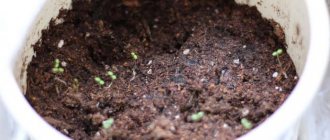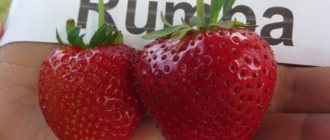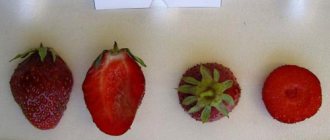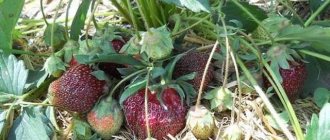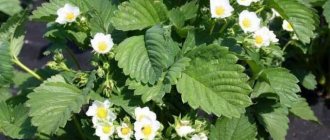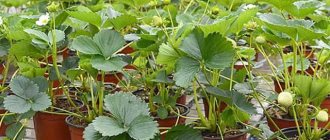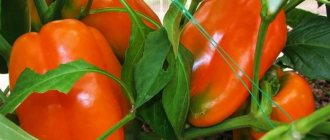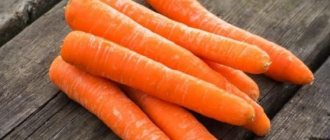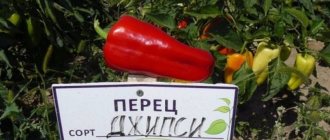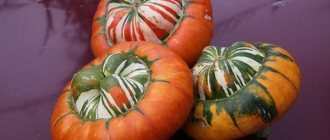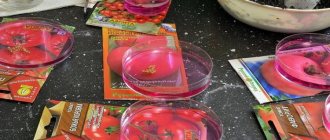Origin, purpose and zoning
Bereginya is a hybrid strawberry variety. It was brought out by a team of agricultural technicians led by S. D. Aitzhanova. All of them work at the Kokinsky support base of VSTISP (All-Russian Selection Technological Institute of Horticulture and Nursery Growing). It was created on the basis of the Agricultural Academy in the city of Bryansk.
Bereginya adopted its resistance from its parent variety Solovushka
Parents of the variety:
- Strawberry Nightingale. Its originator is also S. D. Aitzhanova. The variety is valued for its resistance to diseases, pests, cold and temperature changes.
- Garden strawberry Induka. This is a variety of Dutch selection. Its advantage is a good harvest.
Some sources on the Internet indicate Gonzago and American Concord as parent varieties for Bereginya. It's a lie. This information is not true.
Bereginya combines the best characteristics of the parent varieties. Therefore, it is of interest to summer residents and individual gardeners and professionals from agrotechnical companies.
The variety was registered in the State Register of Breeding Achievements of the Russian Federation after long testing in 2012.
Bereginya is officially zoned only in the Central Federal District of Russia. However, it is cultivated by gardeners in the Middle Zone, the South, the Urals and even Siberia.
Yield Characteristics
The Bereginya variety is known among gardeners for its high yields. With quality care, you can get up to 500 grams from one bush. berries In the second year of fruiting, the yield often increases and reaches 700 grams per bush. If we talk about characteristics for farmers, up to 30 tons can be produced from one hectare. Different sources contain different data, but this scatter is explained by different climatic and other growing conditions for the Bereginya variety.
Important nuance! Reviews from gardeners indicate that during the ripening process, the berries of this variety practically do not become smaller. In this characteristic, only Tsarina can compete with the Bereginya variety.
According to the observations of gardeners, Bereginya is distinguished by its good adaptability to severe frosts. Due to the fact that the buds of the Bereginya berry wake up later than the others, the plant does not have time to fully awaken during the thaw process. In the language of breeders, the frost resistance coefficient is 1.5. Due to the fact that one of the parents of the species is domestic strawberry, Bereginya is quite resistant to fungal infections of leaves. The type of berry also resists diseases such as mites or fungi well.
If the summer is too wet, the berries may contract gray rot. Therefore, the authors of this plant themselves recommend growing it in regions closer to the South, where the amount of moisture is minimal. If the plant type is grown in temperate latitudes, then it is necessary to give the shrubs sufficient space between each other. It is advisable to carry out mulching using black agrofibre or simple garden straw.
Features and characteristics of Beregini
Description of the variety:
Plant structure
| |
Fruit ripening
| |
Description of berries
| |
| Purpose Bereginya is a dessert variety of garden strawberries. That is, they eat it fresh. However, it can be frozen or processed. Strawberries are made from:
| |
| Storage and transportation Due to the high density of the fruits, they are stored for a long time and can be transported over long distances without problems. | |
| Productivity Bereginya belongs to the highly productive varieties:
| |
Organoleptic and taste qualities
Tasting rating from professionals - 4.5 points out of 5 | |
| Sustainability 1. Bereginya withstands frost, heat, temperature changes and drought. 2. The variety is not afraid of fungal diseases. 3. In wet seasons, the crop may suffer from gray rot |
Features of fruiting
A variety of traditional one-time fruiting (non-repairing), included in the category of late or medium-late in terms of ripening. In reviews of the Bereginya strawberry, gardeners indicate that the first berries begin to ripen mainly in the 3rd decade of June, 5-7 days earlier than Malvina, the latest variety of the crop existing today. The variety is characterized by intensive long-lasting flowering, extended fruiting and its stability over the years.
The advantages of the variety include consistently high productivity and preservation of large berry sizes for 4-7 years.
The bushes are small, semi-spreading, densely leafy. The leaves are light green in color, with a glossy sheen, medium wrinkled, slightly ribbed, concave, with blunt, wide teeth along the edges. Leaves, petioles and peduncles are pubescent. Compact multi-flowered inflorescences are formed on peduncles located at the level of the leaves. The flowers are medium-sized, white, bisexual, untwisted.
Whisker-forming activity is high: whiskers, which are pale red in color, grow in large numbers. The variety reproduces well by daughter rosettes.
Characteristics of berries
The berries are large in size: the average weight for all harvests is 12.5-15 g (not critically smaller towards the end of fruiting and over the years), the maximum for the first fruits reaches 30-35 g, according to some reviews - up to 50 g. The shape is regular, blunt-conical, without neck. The color of ripe berries is orange-red with a glossy sheen.
Berries of the Bereginya variety have high commercial and consumer qualities
The pulp is red, juicy, dense, sweet and sour, with a pronounced aroma. The taste is described as balanced and harmonious, sugary, with a light, unobtrusive sourness. Professional tasting assessments of fresh fruits – 4.5 points (out of 5). Given the excellent taste and high percentage of vitamin C, the berries are recommended for fresh consumption and are classified as table (dessert) for their intended purpose, also suitable for processing and freezing. According to the originator, they contain:
| Useful and nutritious substances | Quantity |
| Sahara | 5,7% |
| Acids | 0,8% |
| Vitamin C | 79 mg% |
The berries have good transportability and shelf life. During the testing period of the variety, yields averaged more than 150 c/ha (131-201), and the maximum possible is considered to be up to 300 c/ha.
What gardeners say
Reviews from gardeners:
Tatyana, 34 years old:
“I have been growing Beregini for several years now. I can say that with the help of this variety it is possible to get a high yield, although it has its drawbacks. I consider late maturation to be one of them. So those who want to enjoy ripe fruits early should turn to other varieties of strawberries. Beregini berries are distinguished by their juiciness and incredible aroma, and they also tolerate transportation well. Productivity is high, fruits ripen together. I use the berries to make jam and compote, and the children can also enjoy fresh strawberries. So that the bushes do not freeze in winter, I sprinkle them with pine needles and fallen leaves.”
Source gidfermer.com
Polina, 52 years old, Moscow region:
“I planted this variety on my plot 3 years ago. I'm very pleased with them. The bushes are still bearing fruit consistently in one place, and the berries are not getting smaller either. The first ones are the largest. In subsequent harvests, the size of the berries is rather average, around 10–12 g, but the taste is even more intense. They make wonderful jam and other winter preparations.”
Source ogorodum.ru
Description of the variety
Strawberry, or garden strawberry, "Bereginya" forms medium-sized, semi-spreading, densely leafy bushes. The mustache is medium-sized, pale red in color. For every strawberry bush there is a significant number of whiskers. The leaves are medium-sized, light green in color, moderately wrinkled, with slight ribbing, concave, with pronounced pubescence, shiny. The teeth on the leaves are blunt and wide.
Petioles are medium in size, with slight pubescence. The stipules are wide and quite long. Flowering is bisexual. The flowers are medium sized, white. The peduncles are short, located at the same level with the leaves, and have dense pubescence. The inflorescences are compact and multi-flowered. Medium sized stalks.
The berries are not too large, have an average weight of 14 to 26 g. They have a regular blunt-conical shape, without a neck, and are orange-red in color with a pronounced shine. The tasting score for fresh, fully ripe berries is 4.5 points.
Planting strawberries
The photo shows sandy loam soil, it is ideal for planting Beregini
- Bereginya prefers sandy loam soil, well illuminated by the sun. If you plan to plant strawberries in the spring, then the soil is prepared in the fall. First it loosens. Then organic (humus, compost) and complex (phosphorus, nitrogen, potassium) mineral fertilizers are added to it.
- In early spring, the beds are marked out for holes for seedlings. This is done based on the diagram: the step between the bushes is 0.3-0.45 m, the distance between the rows is 0.5-0.7 m.
- After the holes are dug, the selected seedlings are lowered into them. Then they are covered with soil and watered.
- Then the beds are mulched with organic material (straw, hay, sawdust). This layer retains moisture in the soil, protects the root zone of plants from diseases and pests, and insulates the bushes.
The seedlings take root in fertilized and moistened soil.
Video about planting strawberries in the fall:
Cultivation care
During the period of active growth, strawberries are watered frequently, twice a day.
- During the growing season, you need to water strawberries a couple of times a day: in the morning and evening hours. The water must be purified and warm. For 1 m² you need 12–15 liters of moisture.
Complex fertilizer will help you harvest a rich harvest
- Strawberries need to be fed at least three times during the season . When the seedlings are rooted, complex preparations are used. Following the flowering of Beregini, potash fertilizers are used. To prepare strawberries for wintering, organic fertilizers (compost, humus, enriched peat, etc.) are used.
- After each watering, the soil should be loosened at the strawberry roots . These measures make it easier for the plant to absorb oxygen.
- Do not forget that weeds actively interfere with the development of cultivated plants. They need to be removed regularly. The optimal algorithm for destroying harmful plants is once every 10-14 days.
Fungicide will protect the crop from diseases
- The plant must be protected from diseases and pests. If a white or gray coating, multi-colored spots, or corroded areas appear on its leaves, then it is affected by fungi, bacteria or parasitic insects.
To cure strawberry diseases, it is sprayed with fungicides. These could be the drugs Horus, Strobi, Falcon, Topaz. Their dilution rate is 6-9 g/10 l of water. To rid the plant of pests, insecticides are used. These may be the drugs Envidor, Calypso, Actovit, Confidor. They are diluted and used according to the instructions.
After harvesting, dead organs are removed from the bushes
- When the strawberries finish bearing fruit, their bushes are cleared of damaged and dead leaves and peduncles.
- Then the Beregini plantation is prepared for wintering. To do this, the crop is fertilized with a complex preparation and then mulched with film or organic material.
Reviews of strawberries Bereginya
We recommend reading our other articles
- Proper care of cucumbers in a greenhouse
- Plum variety Angelina
- Pear variety Forest Beauty
- Recipes for adjika from plums
Of course, Bereginya strawberries have a number of disadvantages, like any other variety or hybrid. But for the most part, gardeners and gardeners speak warmly of it.
Photo of strawberry juice and jam
- Nadezhda Glushkova: “Excellent strawberries, especially the taste! But he really can't stand the heat. I live in the central region, but last summer was very hot. Some bushes could not be saved. I carried out frequent watering, fertilizing, and shaded it with screens and canopies from the sun, but not all the plants were saved. Now I’m more attentive to planting sites - I choose partially shaded areas.”
- Gennady Vasilyevich: “On my farm, I have been growing Bereginya strawberries for three years now, along with such varieties as “Alpha” and “Queen Elizabeth.” The harvest is sold, some part is spent on personal needs: food, conservation. The harvests are more than sufficient. The berries are beautiful, juicy, and tolerate transportation well!”
- Larisa Shchekaleva: “Several years ago I tried to plant the variety at my dacha (Ural). She was afraid that Bereginya’s strawberries would withstand frost; most of the bushes survived the first winter. Now I mulch it for the winter - it comes off quickly in the spring, there are usually no frozen bushes, with rare exceptions - in general I’m happy with the variety.”
